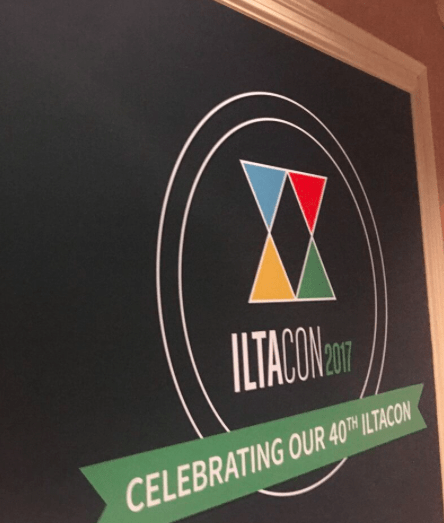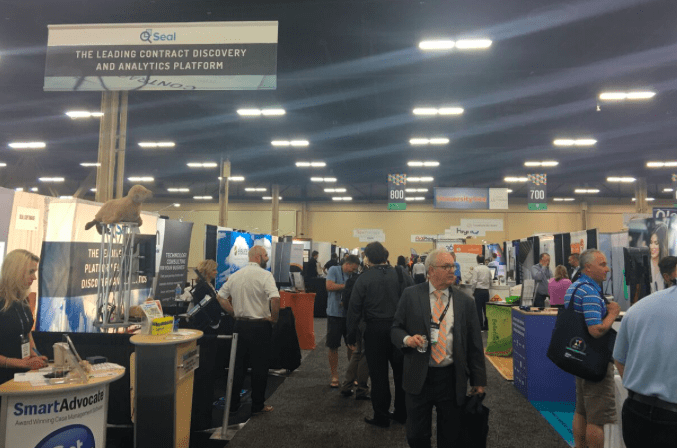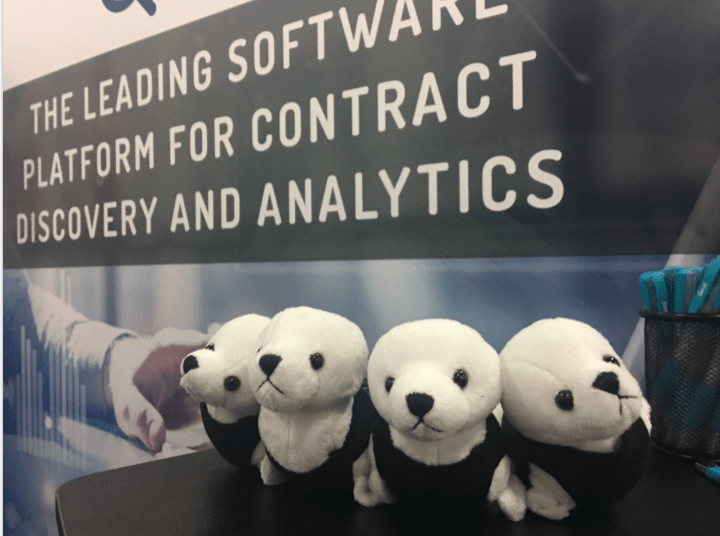
In this final ILTACon17 special, star Guest Blogger, Matt Golab, of Gilbert + Tobin, concludes his coverage of the massive US legal tech event in Las Vegas and shares his impressions and feelings about what he saw, who he met, how much he won at poker and what he learned. (N.B. an extra thanks again to Alicia Ryan of Fenwick & West, who has also been blogging all week.)
This is followed by a Guest Blog post by Ashley Woolley, Senior Marketing Manager at US-based legal AI company Seal Software. Here, Ashley considers what ILTACon17 taught us about the use and adoption of AI systems.
Leaving Las Vegas…With AI Insights
By Matt Golab
I had somewhat optimistically pencilled in a shortlist of 38 different sessions, and 4 vendor meetings, and about a dozen specific vendor booths to visit. I ended up attending 15 sessions, but got to see all of the vendors that I had targeted.
In addition to the formal sessions, and the astonishing range of vendors in the vendor hall and in the private vendor rooms, the other significant drawcard is the networking, both with colleagues that I know and meeting new colleagues, (I met quite a few Canadians this trip as well as some American corporates).
You may have already gathered that there is a lot of walking involved. Being an analytical type I thought I’d share some stats – 61,744 steps and 51.48km, or a daily average of 12,348 steps and 10.296km.
Fortunately I have a lovely 16+ hour flight ahead of me in 24 hours’ time where I can ‘relax’ and rest my feet. Being slightly taller than average this means that achieving optimum leg configuration will be a challenge.
The other environmental factor is the summer desert heat in Nevada is quite considerable – particularly given I’ve come from our Sydney winter. Sure we have mild winters compared with the Northern hemisphere, however its still a temperature change of about +20c to +25c. Fortunately exposure to the outdoors was minimal as this was largely limited to evening excursions.
What I Learnt About AI
Anyway, you didn’t come here to hear my gripes, you came here for the hot AI action – I get it!
On Day 4, there weren’t any AI sessions [or at least in my current state of cognitive impairment I wasn’t aware of any] and the day’s sessions were largely focussed upon Knowledge Management and Information Governance.
Traditionally, the biggest parties are on the Wednesday night, so I feel for the 8AM sessions – I unfortunately hadn’t yet reached the caffeine levels where I could get to them.
Upon reflection, my biggest AI observation about this year is that whereas in 2015 there was a lot of talk about the threat of AI and ‘the singularity‘, this year there was a lot of discussion about ways in which AI has been implemented and tips and tricks about how to effectively implement AI and to use it to augment lawyers.
What is interesting about this is that I have a hunch that although litigation is a really big deal and vast industry in the US market, M&A and due diligence/contract review is the next frontier for AI.
From a vendor perspective, if I had to guess I’d say that there were probably about 6-8 AI centric vendors (i.e. not resellers of Relativity – not that there is anything wrong with that!), and that of these vendors they were roughly split 45% / 55% in contract review AI / eDiscovery. (Now is probably a great time for me to roll out one of my all time favourite jokes…. 85% of all statistics are made up! – boom).

(Another observation is that Andrew Arruda from ROSS Intelligence, was on every AI panel – largely as the moderator.)
From an eDiscovery perspective the trend was to have fact-based or entity based interfaces. An entity being:
- Person / email alias/address normalisation;
- organisation;
- country;
- currency;
- date/time;
- number;
- mobile numbers
These are then presented in network maps – for example you may have mobile numbers and time and currencies as nodes in the network map so that you are able to see at a glance the flow of information/money.
Signing off from Mandalay Bay, ILTACON 2017.
What ILTA Taught Us About AI Adoption

In our past experiences with ILTACON the focus has shifted year-over-year from process best practices to the marriage of advanced technology and processes. This year was no exception. And, while we’ve all heard of artificial intelligence (AI) as a black box that sounds interesting, we’ve seen that the concepts of the future have finally materialised into real-world case studies and demonstrable results.
Smart software companies have built real AI-based solutions, and people are using them daily to do their jobs better and more efficiently. Even better, they’re all excited to talk about it.
We’ll focus this ILTACON blog specifically on the topic that generated some of the most buzz from this year’s show, which was the rising need for AI-based technology in the ever-growing contract space among law firms and legal departments.
As such, many educational sessions this week focused on answering one big question:
If I invest in an AI-based solution for legal, will it solve all of my problems right out of the box?
The ubiquitous answer is no, it’s not that simple. AI is incredibly powerful, but we need the right tools, people, and processes to make the most of the technology.
To quote a friend from one of the largest law firms in the U.S: ‘Nobody is building AI for everything. Everyone has a specific use case.’
In translation, you can’t buy one tool and expect it to solve all your problems — and there are a number of vendors out there with great products. That’s why many ILTACON sessions focused on some helpful tips for navigating the ever-confusing AI space to make the right decisions for your business. Here are some tips we heard from the conference’s thought leaders:
- Choosing a software vendor is a big process, which is not to be taken lightly.
- It’s important to map out your specific business requirements, request customised demos and use cases from your potential vendors, and weigh your options.
- Price is certainly a factor to consider, but it shouldn’t be the factor. Some solutions may be well worth the up-front cost when you see your returns in cost efficiencies across your line of business.
- Build alignment among decision makers while writing your vendor scoring model. Some teams are using detailed scoring models for every tool in the market, and some would prefer to simplify it to a few key priorities, such as:
- Is the solution available on premises, in the cloud, or both?
- Which of my current systems connect to this solution via APIs?
- How reliable is the support team I’ll work with closely?
- What comes baked into the product, versus custom development?
- How customisable is the product for our needs?
- Are pre-defined extraction suggestions available?
- Understand that the better you train any AI-based system via intelligent human interaction, the better the machine learning and ultimate performance will be.
AI-based solutions primarily rely on machine learning. For the machines to learn, you need humans to provide samples, tell the product how to do its job, and correct it when it’s a little off course.
- There may be resistance with your attorneys to adopt new technologies, so take it slow.
It’s tough to imagine someone else doing your job better than you do, let alone a computer — so, it’s important to recognize that your attorneys, whether in-house or at a firm, may be a bit hesitant to trust an AI-based system.

During Liberty Mutual’s educational session about their use of AI for legal, they gave great advice on the process for slowly introducing solutions to their team. First, show them that your data can be extracted and placed into a secure repository where it is accessible and actionable.
Then, show them how to better navigate their data and find what they’re looking for using advanced searching models and visual dashboards. Finally, identify career growth opportunities based on their skills and the ability to automate menial tasks. The result? A significantly more productive team.
The best way to summarise this year’s hot ILTACON topic — AI for legal — is to quote Neota Logic: ‘AI intelligence = your intelligence.’
AI can make cars drive themselves, mobile phones talk to you and music services serve up your favourites, but when it comes to legal, it’s the synergy of human decisions and innovative technology that makes an enormous difference in your work output and bottom line.
We’re thrilled to have seen so many smart ILTACON-goers, legal practitioners and technologists alike, come together to share their knowledge and experience this week, and we can’t wait for the conference next year!

